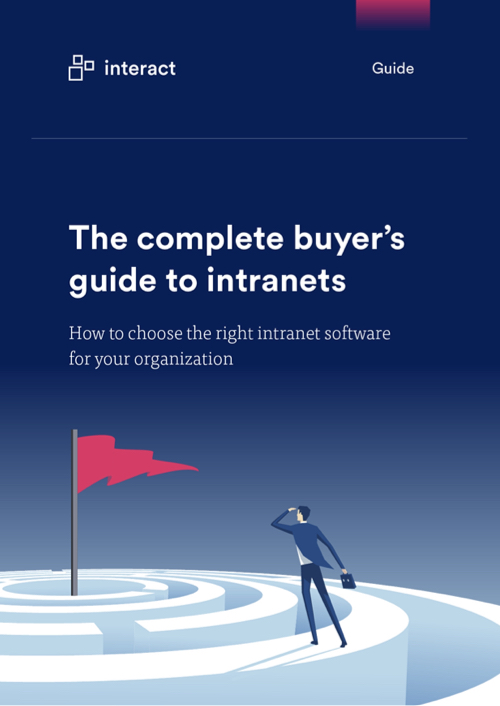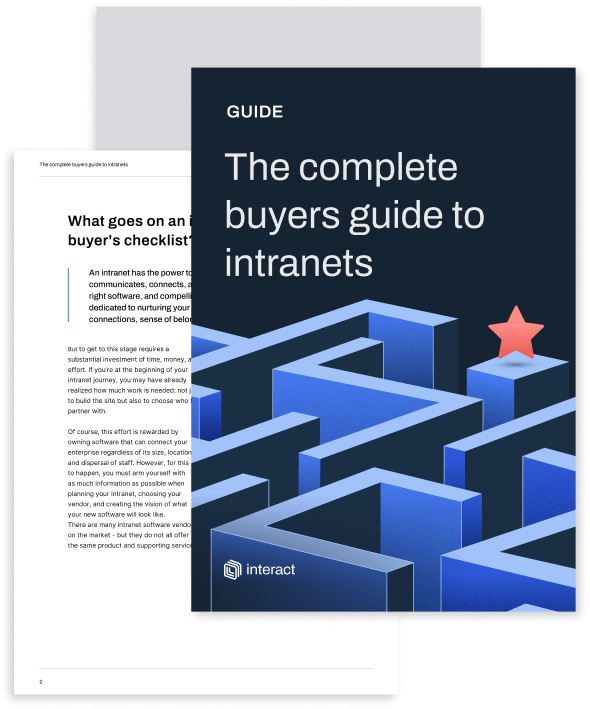Is now the time to start shopping for a new intranet? Learn whether you need a new internal communication platform with these 10 common indicators that something needs to change in your digital workplace.
Organizations implement intranets to facilitate time-critical communications, connect their people, drive collaboration, and place knowledge, tools, and resources at employees’ fingertips.
At least, that’s what they’re supposed to do. And, if they’re regularly updated and governed properly, they do—please check our ebook on award-winning intranets for more on those successes.
However, an intranet is an ecosystem built from a combination of technical features and human input, so how well it performs depends on many factors. Whether you’re using out-of-the-box software such as Interact or a platform that has been custom-built in-house or by a third party, it’s worth periodically reviewing its features, functionality, and the value it brings to your organization.
It can be difficult to acknowledge that the solution you’ve invested in is not delivering in the way that it should be. In psychology, this is explained through theories such as the sunk cost fallacy and commitment bias, and it’s a trap you must avoid if you want your intranet to deliver a return on investment.
The complete buyer’s guide to intranets
Here are 10 tell-tale indicators that will help you identify whether it’s time to retire your existing intranet and implement a new one that will help your organization achieve its goals.
10 reasons why you need a new intranet
#1 Your organization is still stuck in siloes
If your organization has rigid departmental siloes that are inhibiting communication and collaboration, your intranet may not be doing its job properly. This can result in departments being unaligned and pulling in different directions when it comes to purpose and processes. A good solution should break down siloes and unify dispersed people and teams.
There are various ways that an intranet worthy of investment should strengthen weak ties in your organization. These include:
- Including areas of expertise on user profiles that can be picked up through search, allowing employees to connect and collaborate easier.
- Helping employees connect and work together through dynamic content recommendations that show them user-generated content on topics they’re interested in.
- Encouraging users to share knowledge through simple and intuitive content publication.
- Allowing content to be shared through multiple channels, and ensuring individuals receive pertinent content through the channels they’re most receptive to.
#2 Your current intranet is not a productivity tool
An intranet can be more than a platform for sharing communications and knowledge. It can also be a powerful productivity tool and a hub for the other employee portal examples people rely on every day. Navigating multiple apps, tools, and resources in today’s digital workplaces can be a laborious and fragmented experience that limits productivity and adds an element of monotony to the employee experience.
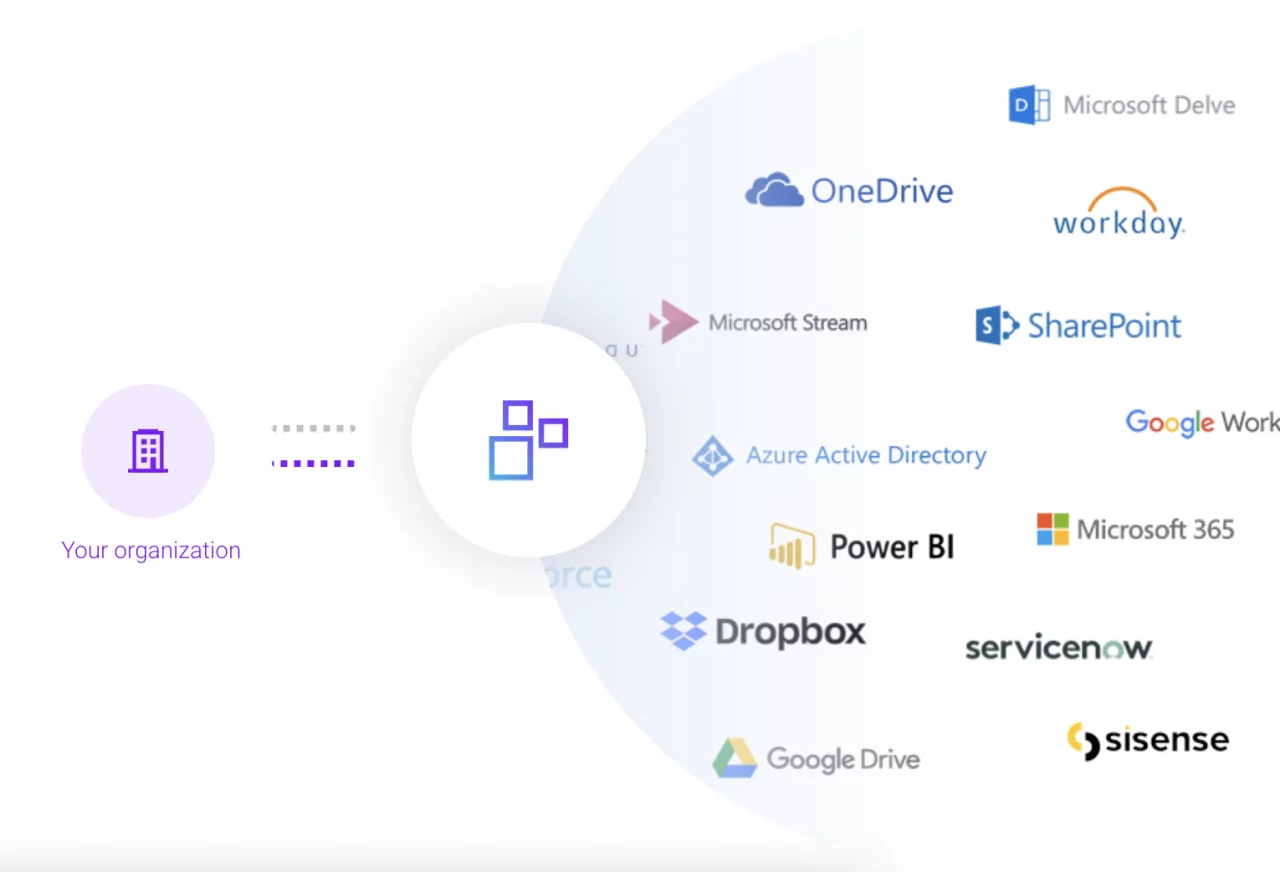
Essential factors that help enable a seamless digital employee experience include:
- Integrations with leading third-party applications—from Slack and Salesforce to Microsoft 365 and Google Workspace.
- Single sign-on (SSO) authentication enables every employee to sign in to all of their integrated applications as soon as they log in to the intranet. This saves time and increases security.
#3 Lack of personalization is switching employees off
It’s all well and good keeping your homepage updated with fresh news and content but, as every comms professional knows, content relevancy is key to intranet success. You can’t guarantee that every piece of content you publish will be relevant to every employee, and this is where a solution with content personalization features can help to ensure every employee has an experience that is tailored to their needs and interests.
The following capabilities can provide a truly personalized experience for every employee:
- Dynamic user groups – known in Interact as Personas – which allow you to target specific communications to relevant employee groups.
- Tailored intranet homepages that adapt for different user groups based on attributes, including department, brand, and location.
- Automated content recommendations that push specific pieces of content to users based on their interests.
The complete buyer’s guide to intranets
#4 Morale is low across your organization
While an intranet can’t be solely responsible for keeping morale up, it can play a vital role in helping communicators to spread positivity and empower employees to do the same. From sharing inspiring stories about how your organization is making a difference to having senior managers call out specific achievements, a new intranet can be a powerful platform for boosting morale.
Here are three ways intranet software can help raise morale:
- At Interact, we have gamified the process of giving rewards and recognition. Co-workers are encouraged to award each other digital donuts via our own intranet. These can then be accumulated and traded like digital currency for material items. I’ll soon have enough for that deluxe foot spa!
- Social intranet features such as a homepage feed where employees can post blogs and updates, and like and comment on each others’ posts are great for giving everybody a voice. This is an effective way to create two-way conversations instead of solely top-down comms, especially when leaders and senior management engage with employees through these features.
- Building a sense of community through forums and discussion groups where employees can discuss anything work or non-work related (within reason).
#5 Your current intranet does not reflect your internal branding
Having a design that your users will identify with can increase adoption and engagement, yet so many intranets lack an aesthetic connection with the organization’s branding, or they don’t reflect a strong internal brand, as our friends at Nielsen Norman so eloquently point out.

When it comes to nailing an intranet design that users will recognize and love, it helps to work with a vendor that can provide the following:
- In-house design specialists who understand who you are and what you stand for, and translate that into the perfect look and feel.
- Customization options. If something about your brand changes, it should be possible to adjust your intranet design to reflect that.
- Thematic customization so you can have fun with themed makeovers marking important internal communications calendar dates such as Pride, Black History Month, and Women’s History Month.
#6 You’re seeing a negative return on investment
Tracking your return on investment (ROI) can be difficult. Typical intranet benefits organizations expect from their investment include increased productivity, improved engagement, a more positive company culture with better employee wellbeing, and increased employee advocacy. If your intranet is failing to deliver in one or more of these areas, then it’s failing to deliver good ROI.
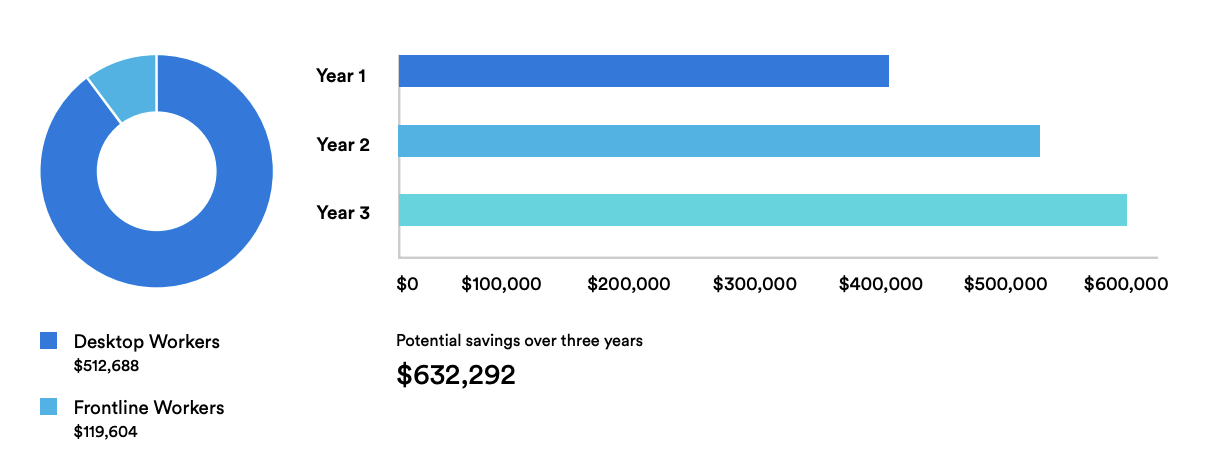
Our intranet ROI calculator is a quick and easy-to-use resource for helping you to understand how you could maximize your investment with a customizable out-of-the-box solution from Interact.
The complete buyer’s guide to intranets
#7 Maintaining and updating your intranet is a strain on IT
If making changes to your intranet requires input from already overburdened IT personnel, you’ll be well aware of the strain this may cause when frequent changes are required. For organizations whose intranets have been custom-built in-house, managing and maintaining a platform can be an ongoing burden for IT.
Here’s what to look for in an intranet that both IT and Comms teams will love:
- Rigorous security protocols and up-to-date compliance certifications from the intranet vendor.
- A product roadmap that includes a continual flow of software updates and new features.
- A low-code or no-code platform that allows non-technical professionals to make and adjust pages using simple drag-and-drop controls rather than having an IT person make changes through time-consuming coding.
- A virtual space that houses IT knowledge and enables self-servicing.
- Direct vendor support whenever you need it.
#8 Your intranet isn’t really an intranet
At Interact, we’re often approached by organizations who want to replace an intranet based on software that isn’t built to function as a viable internal communications platform. Microsoft SharePoint is the most regular example. If you need expert advice on the thorny question of SharePoint intranet alternatives, check out our webinar on the topic.

While Microsoft has rolled out changes to try and position SharePoint as a viable intranet, it is still fundamentally a file storage solution. What it doesn’t do is connect dispersed workplaces through multichannel communications, which is really the very least that an internal communicator wants their intranet to do.

There are many reasons why SharePoint isn’t really an intranet, but these are its most obvious limitations:
- Customization is difficult and SharePoint developers can be hard to find and expensive.
- Personalization options are limited compared to the options you get from vendors of purpose-built intranet software.
- Adding, updating, and lifting and shifting content can be difficult compared to performing the same task in a purpose-built solution.
- New features may be “forced down,” meaning you don’t get any say in how the platform you’re paying for develops. With Interact you can choose to switch new features on or off.
#9 Your current intranet isn’t getting enough engagement
Great engagement is what every organization wants, yet achieving this can depend on the capabilities of the platform in use. So often, engagement is stifled by a lack of balance between too many top-down comms and not enough two-way conversations. Employees can also hold off from engaging when they are inundated with so much content that the relevant bits just get lost in the noise.
An intranet that can help to maximize engagement should exhibit the following:
- A space for two-way conversations alongside top-down comms on the homepage, such as a feed of employee-generated content, or recent community discussions.
- Social features – as previously mentioned, the ability to like and comment on other people’s posts can generate great engagement.
- Advanced permissions that allow internal influencers and brand advocates to create media-rich intranet content that helps to build a better culture of communication.
#10 Your intranet is shutting employees out
A great intranet that your employees love should allow access for everyone in your organization, wherever they are. When certain employee groups such as deskless workers can’t access your intranet then they can feel excluded, and this could make them less likely to adopt and engage during those moments when they can access it. Many organizations have been slow to open up access to those who aren’t sitting at a computer all day, but a modern solution like an Interact intranet can provide an ‘intranet everywhere’ approach.
Here’s what to look for in an everywhere intranet:
- Mobile-responsive design that optimizes your intranet to look great when accessed via a browser on an employee’s smartphone or tablet.
- An employee app that provides seamless mobile access to your intranet without having to type in a URL.
- Digital signage to extend the reach of intranet content to employees in warehouses, kitchens and other locations where they may not have any devices to hand.
Ready for a modern intranet?
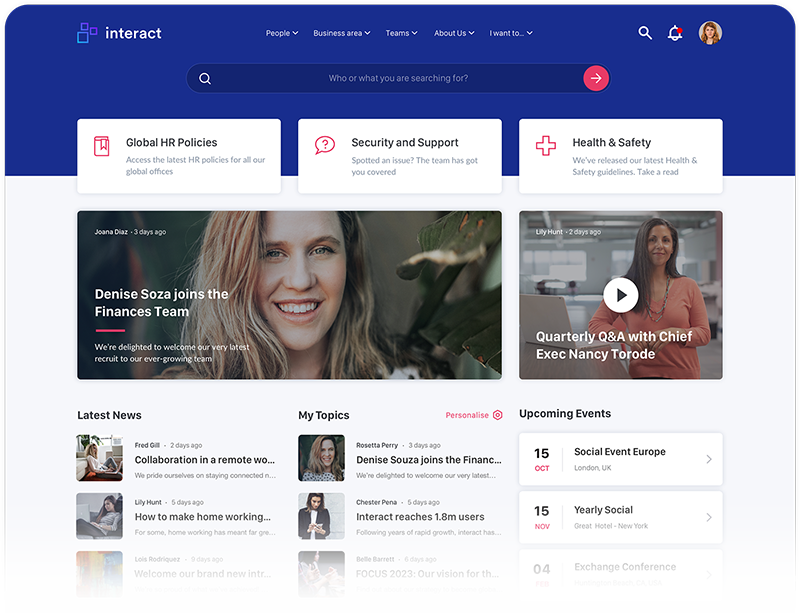
Intranets have gone through many evolutions, from the clunky document storage systems that only the older among us will remember, to the company notice board-style solutions that had document storage bolted on but were noticeably lean when it came to features. The latter is still surprisingly common today, but there really is no excuse for a no-frills intranet that fails to communicate company missions and values, struggles to generate engagement, creates headaches for both IT and IC teams, and doesn’t give your employees a voice.
With the insights we’ve provided into what an intranet can and should do for your organization, we hope you can make an informed decision about whether or not it’s time to upgrade to modern intranet software.
